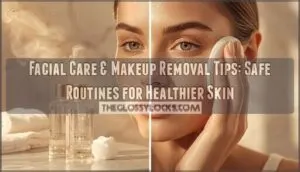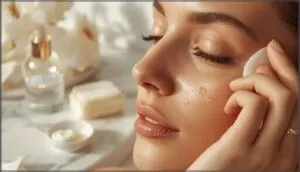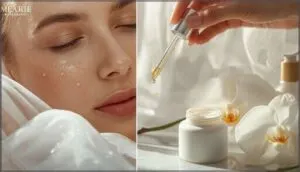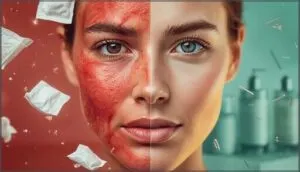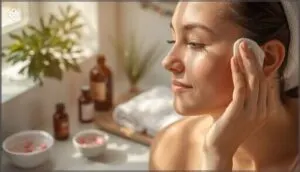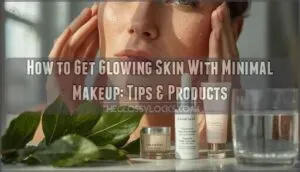This site is supported by our readers. We may earn a commission, at no cost to you, if you purchase through links.
You wash your face every night, but if you’re still breaking out or noticing dull, tired-looking skin, your makeup removal routine might be working against you. Most people don’t realize that foundation, mascara, and even tinted SPF create an invisible film that traps dead skin cells, oil, and pollution deep in your pores—no matter how thoroughly you think you’re cleansing.
Over time, this buildup doesn’t just trigger breakouts. It quietly accelerates fine lines, blocks your serums from doing their job, and keeps your skin stuck in a cycle of inflammation.
The good news? A few strategic tweaks to your facial care and makeup removal habits can reverse the damage and give your complexion the clean slate it needs to actually heal and glow.
Table Of Contents
Key Takeaways
- Leaving makeup on overnight traps oil, dead skin, and pollution in your pores, which triggers breakouts, accelerates fine lines, and blocks your serums from working properly.
- Double cleansing—starting with an oil-based remover followed by a water-based cleanser—removes up to 94% of waterproof makeup while preventing clogged pores and allowing skincare products to penetrate effectively.
- Common mistakes like overusing makeup wipes, rubbing delicate eye areas, and skipping nightly cleansing cause barrier damage, premature aging, and a 27% increase in breakout risk.
- Applying hydrating serums or moisturizers within 40 minutes after cleansing locks in moisture and supports your skin’s natural barrier repair, preventing the dehydration that leads to irritation and sensitivity.
Why Makeup Removal is Essential for Skin Health
Taking off your makeup at the end of each day matters more than you might think. The way you remove it has a big impact on how your skin looks and feels.
Here’s what you need to know about why this step is so important.
Preventing Clogged Pores and Acne
When you leave makeup on overnight, those pore-clogging ingredients and lingering powders act like a magnet for breakouts—especially if you’re prone to acne triggers. Makeup with harsh ingredients can compromise the skin’s natural protective barrier.
Gentle cleansing every night protects your skin microbiome, sweeps out irritants, and helps with pore minimization. Pair preventative exfoliation with thoughtful facial cleansing and you’ll see smoother, clearer skin start to surface.
Reducing Skin Irritation and Inflammation
Tough days and tough scrubs go hand in hand, but rough cleansing only stirs up more skin irritation and sensitivity.
Gentle cleansing, paired with soothing formulations and barrier repair, helps calm flare-ups and keeps your skin barrier strong. To help prevent moisture loss, it’s important to use skin-identical ceramides.
Get into ingredient awareness and patch testing, and steer clear of harsh rubs—especially if you struggle with acne or naturally sensitive skin.
Enhancing Absorption of Skincare Products
A smart skincare routine starts with a clean slate. Removing makeup and using gentle facial cleansing opens the door for active ingredients to do their work.
Exfoliation methods smooth skin texture, nanoscale carriers boost absorption, and product layering—with the right application techniques—brings your moisturizers and serums deeper.
That’s how you get the most out of every good thing you apply.
Avoiding Premature Aging and Dryness
The way you remove makeup shapes your skin’s future. It’s not just about feeling fresh—improper cleansing can spark premature aging, steal moisture, and hasten dryness.
Nurture your skin by focusing on hydration importance, gentle exfoliation, and antioxidant serums. Extend your skincare routine to your neck, and never skip sunscreen necessity to help protect against dryness and signs of aging.
Choosing The Best Makeup Remover for Your Skin
Finding the right makeup remover isn’t one-size-fits-all—what works for your friend mightn’t suit your skin. You’ll want to think about your skin’s needs and the kinds of makeup you use every day.
Let’s walk through some key things to help you make the best choice for your routine.
Understanding Makeup Remover Types (oil, Micellar, Balms)
Ever wondered why one remover suits you better than another? Oil-based cleansers dissolve stubborn makeup, while micellar water’s tiny spheres lift away debris—quick for double cleanse routines. Balm benefits shine in removing waterproof formulas.
Application techniques matter: massage oils, swipe micellar, melt balms on dry skin.
Keep an eye on market trends—Remover Ingredients now tend toward gentle, skin-loving options.
Identifying Products for Sensitive Skin
With sensitive skin, Ingredient Awareness is your best ally. Look for removers labeled hypoallergenic and recommended by dermatologists—they’re crafted for skin sensitivity concerns. Product Testing is a must: patch test before fully committing.
Allergen Avoidance matters more than ever, so always scan labels for triggers. If you feel irritation, don’t hesitate to switch to formulas meant for gentle skin cleansing.
Avoiding Irritating Ingredients and Fragrances
Even the most gentle cleanser can lead to trouble if you overlook Product Labels or skip Allergy Testing. People with skin sensitivity concerns quickly learn that fragrances top the list of common irritants. Ingredient Awareness is key—choose unscented or Fragrance Alternatives, and scan for Natural Options that truly support avoiding skin irritation.
For everyday skin cleansing, simpler is safer.
Selecting Removers for Waterproof Makeup
When tackling waterproof mascara or stubborn eye makeup, your remover’s not just a choice—it’s a strategy. Dual-phase or oil-based cleansers glide through long-wear formulas, leaving less residue than makeup-removing wipes.
Use gentle, soaking techniques rather than rubbing for better skin sensitivity outcomes.
For best results, look for products tested for safety and approved by market regulation guidelines.
Step-by-Step Facial Cleansing Routine
Creating a simple and safe cleansing routine isn’t as complicated as it might seem. With a few thoughtful steps, you can protect your skin and keep it looking its best.
Here’s how to get started with each part of the process.
Double Cleansing Explained
Think of double cleansing as a one-two punch for your skin health. Start with an oil-based cleanser on dry skin to dissolve makeup and sunscreen—it removes up to 94% of waterproof residue.
Follow with a gentle water-based cleanser to clear away sweat and dirt.
This skincare routine addresses both oil- and water-soluble impurities, preventing clogged pores and boosting the importance of proper makeup removal for lasting results.
Removing Eye and Lip Makeup Safely
Your eyes and lips deserve extra care during makeup removal—they’re more delicate than you think. Soak a cotton pad with specialized cleansing oils and press gently for 15 seconds before wiping. This gentle pressure application handles waterproof makeup removal without tugging, achieving irritation symptom reduction.
Daily lid cleansing prevents discomfort while protecting skin sensitivity throughout your skincare routine steps.
Gentle Cleansing Methods for All Skin Types
After treating delicate areas with care, your whole face benefits from choosing the right gentle cleanser for your skin type. Syndet benefits include TEWL stability and lipid replenishment—especially important for dry or sensitive skin. Glycerine bars support microbiome balance across all demographics.
Your skin cleansing approach should adapt to your needs: non-foaming formulas work beautifully for daily facial cleansing routine maintenance without stripping essential moisture.
Post-cleansing Hydration and Treatment
Once you’ve cleansed gently, your skin’s hydration drops fast—but bounces back within 40 minutes if you act quickly. Lock in moisture right away to support TEWL reduction and barrier repair. This timing matters for serum efficacy and microbiome diversity.
After cleansing, lock in moisture within 40 minutes to restore hydration and support your skin’s barrier repair
Your postcleansing skincare steps:
- Apply hydrating essence or serum within five minutes
- Choose ceramide or hyaluronic acid formulas for skin hydration
- Follow with moisturizer to seal in treatment
- Build consistency into your skin care routine
Common Makeup Removal Mistakes to Avoid
Even when you have good intentions, certain habits can sabotage your makeup removal routine and hurt your skin over time. These common mistakes might seem harmless, but they can lead to irritation, breakouts, and premature aging.
Let’s look at what to avoid so you can protect your skin and get better results from your cleansing routine.
Overusing Makeup Wipes
While makeup-removing wipes seem convenient, overusing them can cause barrier disruption, residue buildup, and microbiome imbalance. They leave behind debris that clogs pores, potentially speeding premature aging through irritant exposure.
Plus, their environmental impact is staggering—millions of pounds clog landfills yearly.
For effective skincare practices and makeup removal tips focused on skin health maintenance, choose a proper cleanser over wipes to avoid skin irritation.
Rubbing or Tugging Delicate Areas
Another pitfall? Harsh rubbing around your eyes and lips causes periorbital skin damage and friction skin barrier breakdown. That thin skin can’t handle tugging—it leads to premature aging signs like wrinkles and dark circles. Irritation and inflammation flare up fast.
Instead, use gentle removal methods: press a soaked cotton pad on makeup for ten seconds, then lightly swipe. Your skin sensitivity concerns will thank you.
Skipping Nightly Cleansing
When you skip your nightly skincare routine, you’re opening the door to acne aggravation, bacterial proliferation, and barrier disruption. More than half of people admit they don’t remove makeup every night—but that habit accelerates premature aging and skin sensitivity.
The importance of cleansing can’t be overstated: preventing clogged pores and avoiding skin irritation starts with washing your face before bed, every single night.
Neglecting Follow-up Skincare Steps
You cleanse, towel off, and stop—but that’s when the real work begins. Only 40% of people follow through with their full skincare routine after makeup removal, and skipping those steps invites barrier impairment, reduced actives efficacy, and a 27% spike in breakout risk.
Without proper moisture retention post-cleanse, you’re sacrificing long-term skin health and leaving your skin vulnerable to preventable damage.
Expert Tips for Long-Term Facial Skin Health
Taking care of your skin goes beyond washing your face each night. It’s about building habits that protect and strengthen your complexion over time.
Here are the expert tips that will keep your skin healthy and glowing for years to come.
Building a Personalized Skincare Routine
Your skin type, genetic factors, and lifestyle impacts all shape what your skin truly needs. A custom skincare routine starts with careful skin analysis to match products to your unique concerns.
Product layering matters—apply from thinnest to thickest for best absorption. As your skin changes with seasons or stress, routine adjustments keep results consistent.
This skincare routine education enables you to care for your skin confidently.
Integrating Professional Facial Treatments
Professional facial treatments can boost your at-home routine with results you can see and feel. Individual facial plans based on skin analysis target your specific needs through evidence-based outcomes.
Treatment frequency impacts effectiveness:
- Monthly sessions align with your skin’s natural renewal cycle for anti-aging benefits
- Biweekly facials clear stubborn acne faster
- Seasonal treatments adapt to environmental changes
- Economic accessibility varies—most skin treatments range from $75 to $300
Treatment individualization by licensed professionals enhances skincare services beyond what home care alone achieves.
Maintaining Hydration and Barrier Health
Think of your skin’s barrier like a shield—it needs constant reinforcement. TEWL reduction matters because damaged barriers lose up to 60% more water, causing skin dryness and irritation.
Moisturizer impact is real: hydration jumps 59% within one hour of application. Key ingredients like hyaluronic acid and ceramides boost skincare product effectiveness for long-term skin health.
Barrier trends now prioritize hydration and treatment to prevent skin damage.
Monitoring Skin Changes and Sensitivity
Catching redness or texture shifts early makes all the difference in avoiding skin irritation and long-term skin damage prevention. Self-examination paired with AI diagnostics gives you real power over skin concerns across all skin types.
Here’s how to stay ahead:
- Check your face weekly for new spots or sensitivity prevalence changes
- Use digital analysis apps to track skin issues objectively
- Schedule professional monitoring twice yearly for hidden skin concerns
- Document reactions to new products immediately
- Trust AI diagnostics when home checks feel uncertain
Frequently Asked Questions (FAQs)
Can makeup removal cause skin dryness or tightness?
Yes, it can. Harsh remover ingredients and excessive mechanical action during cleansing strip natural oils, causing dryness and tightness.
Clinical outcomes show hydration restoration improves when you choose gentle cleansing methods with moisturizing formulas.
How often should I replace my makeup remover?
Most liquid makeup removers last six to twelve months after opening. Check the shelf life symbol on your bottle, and toss any product that smells off or changes texture.
Does makeup removal affect permanent makeup or tattoos?
Regular makeup removers won’t fade your permanent makeup or tattoos—those pigments sit deeper in your skin.
However, exfoliating ingredients like AHAs can speed up fading over time, especially on microbladed brows.
Should I remove makeup before or after exercise?
Always remove makeup before you exercise. Pre-workout removal prevents clogged pores and skin irritation while your sweat flows freely.
Follow with a post-workout cleanse to support healthy sebum production and avoid pore blockage.
Can I use makeup remover on eyelash extensions?
Walking a tightrope with lash extensions means choosing wisely. Oil-free formulas and micellar water protect lash retention during makeup removal, while oil-based products weaken bonds and trigger adverse reactions, risking premature loss and skincare setbacks.
Conclusion
Your skin has been trying to tell you something all along—and now you know how to listen. Prioritize proper facial care and makeup removal, and you’re not just preventing breakouts; you’re giving every product, treatment, and healing process a real chance to work.
Start tonight with one small shift: a gentler remover, a second cleanse, or simply slowing down. Your complexion will reward the effort faster than you think.
- https://media.market.us/skincare-statistics/
- https://www.tricociuniversity.edu/beauty-blog/skincare-industry-statistics-2025-u-s-market-overview/
- https://www.statista.com/outlook/cmo/beauty-personal-care/skin-care/worldwide
- https://www.advdermatology.com/blog/americas-beauty-budgets/
- https://finance.yahoo.com/news/skincare-products-market-analysis-forecast-092900197.html

